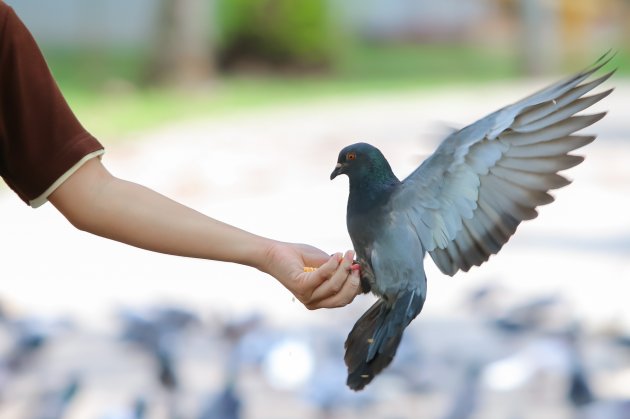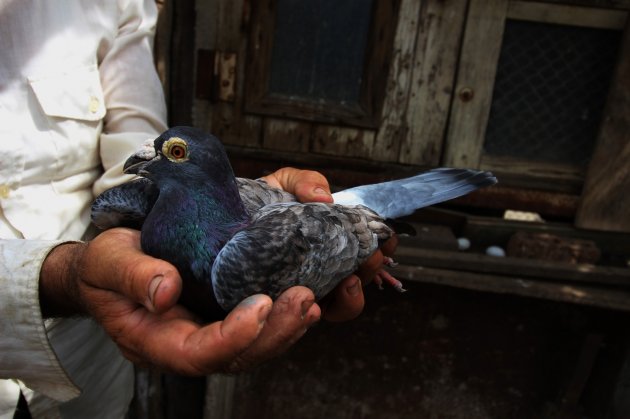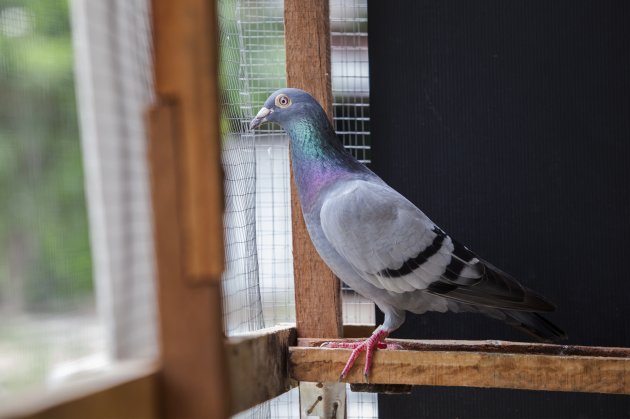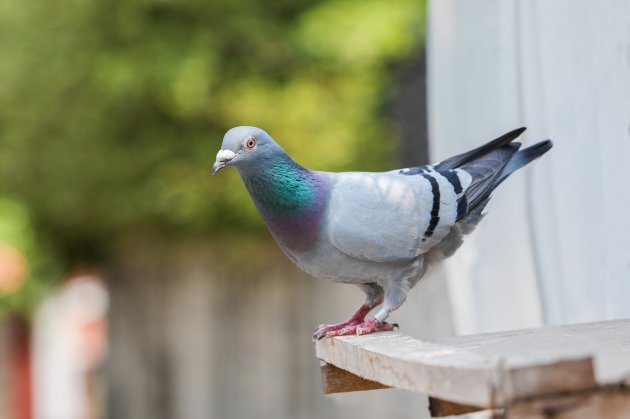The idea of keeping a pigeon as a pet is not a new one. The Rock Pigeon is the world’s oldest domesticated bird. This species is even depicted in the hieroglyphics of the Egyptians. Oddly enough, what makes this bird a “nuisance” to some folks (their feces) is now a valued fertilizer. The Carrier Pigeon is also credited for saving countless lives in World War II. In fact, 32 pigeons received medals of honor for their service of delivering crucial messages across enemy lines.
Sadly, it’s only been in recent times that the pigeon went from a valued “member of society” to reviled pests.
In this post, we’ll discover how to keep the pigeon as a pet, and some cool facts that will hopefully change the minds of naysayers.

The Pigeon Appearance
Pigeons are a large bird measuring up to 14.5 inches from beak to tail. They have a hefty wingspan of 2.4 feet, with orange or red eyes. Pigeons come in a variety of colors and patterns from white to brown to grey with iridescent shades of blue, purple, and green. Their bills are black with an off-white cere, and their thin legs and feet are reddish or light-colored.
Pigeon Behavior
Pet parents of pigeons report a variety of personalities in their domesticated birds. Like dogs and cats, the pigeon can be loving, shy, sweet, calm, and even grumpy;
"He {Pax} does wing-fu, which is when they slap their wings at you. But we’ve gotten used to it.”
{excerpt from the Washington Post}.
This species is comfortable around humans and likes to nap in the sun, bathe, and be social with one another. Studies show that pigeons are an intelligent bird. They can recognize themselves in a mirror, and categorize objects. They have excellent eyesight and have even been trained to identify cancer cells in mammograms, as well as recognizing sailors and equipment lost at sea.

Housing a Pigeon
Pigeons can be kept both inside and outside. Here are some tips on housing your pet pigeon.
Outdoor Enclosure
Pigeons need to be kept safe from predators, so you will need a securely built outdoor aviary. Use a minimum of 16-gauge mesh with openings no more than ½ inch. You will want to have as much room as possible, so build your aviary no less than six feet long by four feet wide, and six feet high. Of course, you will also have to include a roof for safety and protection from the elements and a sheltered corner.
Indoor Enclosure
Your indoor pigeon will need an extra-large double-flight cage for safety and security. However, you will need to let your pigeon pal out to stretch its legs and spread its wings. The indoor pigeon should not be kept inside a cage all day long. This is a social bird that needs interaction from you.
Pigeons also do very well kept in multiples, but you will also want to accommodate them with larger enclosures.

Feeding a Pigeon
In the wild, pigeons eat a variety of grains, seeds, fruits, berries, and greens. They will also occasionally dine on insects, worms, and snails.
The pet pigeon should also be offered a varied diet. You can purchase formulated pigeon mix with grains, seeds, veggies, and added vitamins and minerals.
Note: Pigeons are prone to calcium deficiency which comes from eating too many seeds. Be sure your pet pigeon's seed intake is no greater than 50% of its daily intake.
Pellets should also be offered to your bird, as these are the ideal diet. Prepackaged pigeon pellets are available and should comprise 50% of its daily intake.
Fruits and vegetables thoroughly washed and finely chopped will provide your pet pigeon with added nutrients. However, avoid those high in water content like iceberg lettuce (low nutritional value).
Note: Avocados are also highly toxic to pigeons.
Of course, fresh water should be made available at all times.
Handling a Pigeon
Like any other bird, the pigeon is a delicate creature that scares easily, so you will want to handle him with care.
To safely pick up a pigeon hold your dominant hand out flat, palm facing up, in front of its lower body. Now gently slide your hand under the feet of the pigeon (your pigeon's tail feathers should be pointing towards your thumb).
Let your pigeon's feet slide between your fingers, while you gently grasp its legs. Now wrap your thumb around the end of your pigeon's wings. Don't squeeze or clench your bird. You just need enough pressure to secure the pigeon.
Once you have secured your bird in your hand, use your other hand to help support its body while you bring it closer to your body.
Note: Before you try to physically handle your bird, you should get to know it. This can be accomplished by spending time with your new pet. Talk gently to it, and always move slowly to avoid scaring your bird.

Fun Pigeon Facts
The pigeon is a very interesting bird. Check out these fun facts.
- Pigeons are so intelligent, they can even recognize the letters of the alphabet and people by their photos.
- This bird uses visual landmarks and man-made roads to help guide its path home.
- Pigeons will hang out together in flocks up to 30 members.
- This species of bird mates for life.
- Both the mom and dad pigeon raise the young.
- Pigeons have excellent hearing and can detect a thunderstorm and even a volcano erupting at great distances.
- This bird can reach flight-speeds of 77.6 mph. The fastest pigeon was clocked at 92.5 mph.
- Pigeons can fly at altitudes of over 6,000 feet.
The Pigeon & You
If you are interested in keeping a pigeon as a pet, then be sure to find one that has been hand-raised for the purpose of domestication. Never take a baby pigeon out of the wild. If you have found an injured pigeon, then contact your local wildlife rescue or animal shelter for the best way to help it.
Further reading and references:
- Ludwig Huber. (Institute of Zoology, University of Vienna). Visual Categorization in Pigeons
- Department of Psychological & Brain Sciences at the University of Iowa. Pigeon Research
- Andrew D. Blechman. (September 1, 2018).Pigeons: The Fascinating Saga of the World's Most Revered and Reviled Bird